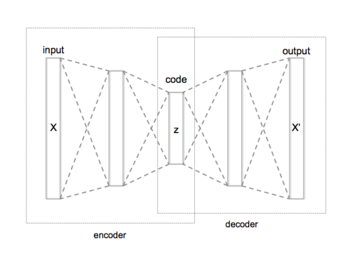一个具有3个全连接隐藏层的自动编码器网络结构。 自编码器 (英語:autoencoder )也称自动编码器 ,是一种人工神经网络 ,用于学习无标签数据 的有效编码 ;属一种无监督学习 。
自编码 (autoencoding)的目的是:学习对高维度数据做低维度“表示”(“表征”或“编码”);因此,
通常用于降维 。最近,自编码的概念广泛地用于数据的生成模型 。[ 1] [ 2] 深度学习 网络中采用了采用堆叠式稀疏自编码。[ 3]
自编码器有两个主要部分组成:编码器用于将输入编码,而解码器使用编码重构输入。
实现这个功能最简单的方式就是重复原始信号。然而,自编码器通常被迫近似地重构输入信号,重构结果仅仅包括原信号中最相关的部分。
自编码器的思想已经流行了几十年,其首次应用可以追溯到20世纪80年代。[ 4] [ 5] [ 6] 降维 或特征学习 ,现在这个概念已经推广到用于学习数据的生成模型。.[ 1] [ 2] [ 3]
最简单的自编码器形式是一个前馈的、非循环的神经网络,用一层或多层隐藏层链接输入和输出。输出层节点数和输入层一致。其目的是重构输入(最小化输入和输出之间的差异),而不是在给定输入的情况下预测目标值,所以自编码器属于无监督学习。
最简单的自编码器形式是一个前馈的、非循环的神经网络,类似于多层感知器 (MLP)中的单层感知器 ,用一层或多层隐藏层链接输入和输出。输出层具有与输入层相同数量的节点(神经元)。输出层节点数和输入层一致。其目的是重构输入(最小化输入和输出之间的差异),而不是在给定输入
X
{\displaystyle X}
Y
{\displaystyle Y}
自编码器由编码器和解码器组成,二者可以被分别定义为变换
ϕ
{\displaystyle \phi }
ψ
{\displaystyle \psi }
ϕ
:
X
→
F
{\displaystyle \phi :{\mathcal {X}}\rightarrow {\mathcal {F}}}
ψ
:
F
→
X
{\displaystyle \psi :{\mathcal {F}}\rightarrow {\mathcal {X}}}
ϕ
,
ψ
=
a
r
g
m
i
n
ϕ
,
ψ
‖
X
−
(
ψ
∘
ϕ
)
X
‖
2
{\displaystyle \phi ,\psi ={\underset {\phi ,\psi }{\operatorname {arg\,min} }}\,\|{\mathcal {X}}-(\psi \circ \phi ){\mathcal {X}}\|^{2}}
在最简单的情况下,给定一个隐藏层,自编码器的编码阶段接受输入
x
∈
R
d
=
X
{\displaystyle \mathbf {x} \in \mathbb {R} ^{d}={\mathcal {X}}}
h
∈
R
p
=
F
{\displaystyle \mathbf {h} \in \mathbb {R} ^{p}={\mathcal {F}}}
h
=
σ
(
W
x
+
b
)
{\displaystyle \mathbf {h} =\sigma (\mathbf {Wx} +\mathbf {b} )}
像
h
{\displaystyle \mathbf {h} }
σ
{\displaystyle \sigma }
激活函数 (例如sigmoid函数 或线性整流函数 )。
W
{\displaystyle \mathbf {W} }
b
{\displaystyle \mathbf {b} }
h
{\displaystyle \mathbf {h} }
x
′
{\displaystyle \mathbf {x'} }
x
{\displaystyle \mathbf {x} }
x
′
=
σ
′
(
W
′
h
+
b
′
)
{\displaystyle \mathbf {x'} =\sigma '(\mathbf {W'h} +\mathbf {b'} )}
其中解码器部分的
σ
′
,
W
′
,
b
′
{\displaystyle \mathbf {\sigma '} ,\mathbf {W'} ,\mathbf {b'} }
σ
,
W
,
b
{\displaystyle \mathbf {\sigma } ,\mathbf {W} ,\mathbf {b} }
自编码器被训练来最小化重建误差(如平方误差),通常被称为 "损失":
L
(
x
,
x
′
)
=
‖
x
−
x
′
‖
2
=
‖
x
−
σ
′
(
W
′
(
σ
(
W
x
+
b
)
)
+
b
′
)
‖
2
{\displaystyle {\mathcal {L}}(\mathbf {x} ,\mathbf {x'} )=\|\mathbf {x} -\mathbf {x'} \|^{2}=\|\mathbf {x} -\sigma '(\mathbf {W'} (\sigma (\mathbf {Wx} +\mathbf {b} ))+\mathbf {b'} )\|^{2}}
其中
x
{\displaystyle \mathbf {x} }
如前所述,和其它前馈神经网络一样,自编码器的训练是通过误差的反向传播进行的。
当特征空间
F
{\displaystyle {\mathcal {F}}}
X
{\displaystyle {\mathcal {X}}}
ϕ
(
x
)
{\displaystyle \phi (x)}
x
{\displaystyle x}
[ 7] [ 4]
^ 1.0 1.1 Auto-Encoding Variational Bayes, Kingma, D.P. and Welling, M., ArXiv e-prints, 2013 arxiv
^ 2.0 2.1 Generating Faces with Torch, Boesen A., Larsen L. and Sonderby S.K., 2015 torch
^ 3.0 3.1 Domingos, Pedro . 4. The Master Algorithm: How the Quest for the Ultimate Learning Machine Will Remake Our World . Basic Books. 2015. "Deeper into the Brain" subsection. ISBN 978-046506192-1 ^ 4.0 4.1 Bengio, Yoshua; Courville, Aaron. Deep learning. Deep Learning . Cambridge, Massachusetts. 2016 [2022-06-06 ] . ISBN 0-262-03561-8OCLC 955778308 原始内容 存档于2021-02-17). ^ Schmidhuber, Jürgen. Deep learning in neural networks: An overview. Neural Networks. January 2015, 61 : 85–117. PMID 25462637 S2CID 11715509 arXiv:1404.7828 doi:10.1016/j.neunet.2014.09.003 ^ Hinton, G. E., & Zemel, R. S. (1994). Autoencoders, minimum description length and Helmholtz free energy. In Advances in neural information processing systems 6 (pp. 3-10).
^ Bengio, Y. Learning Deep Architectures for AI (PDF) . Foundations and Trends in Machine Learning. 2009, 2 (8): 1795–7 [2022-06-06 ] . CiteSeerX 10.1.1.701.9550 PMID 23946944 doi:10.1561/2200000006 原始内容 (PDF) 存档于2015-12-23).
可微分计算
概论 概念 应用 硬件 软件库 实现
人物 组织 架构

























